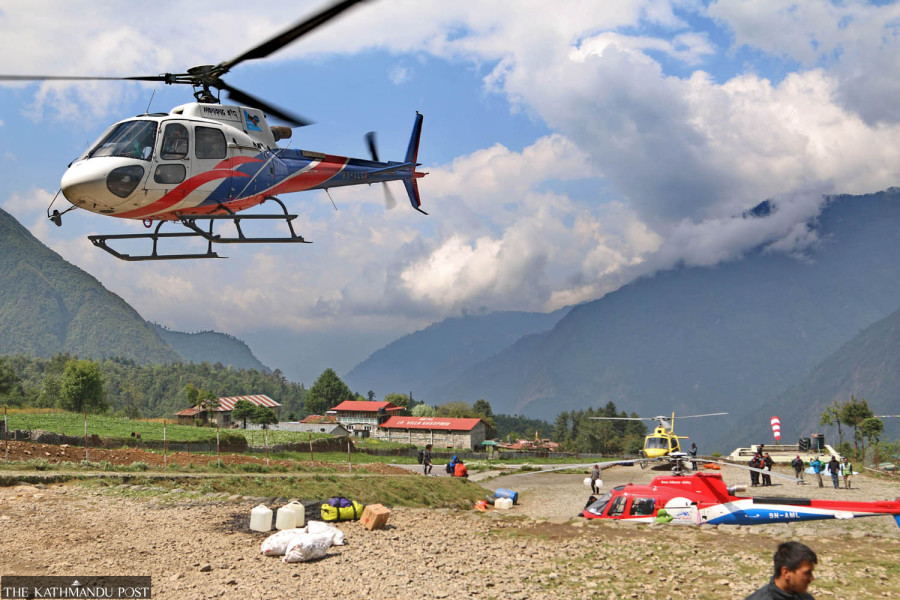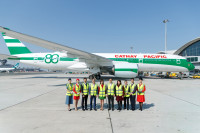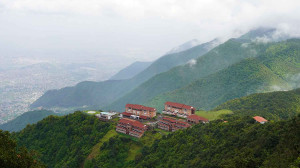Money
Nepal aviation regulator clashes with national park over Everest chopper ban
Dispute pits high-end tourism against conservation in the iconic natural region.
Sangam Prasain
The dispute between the Sagarmatha National Park, home to Mount Everest, and the Civil Aviation Authority of Nepal over restricting helicopter sightseeing tours of the world’s tallest peak has intensified.
A day after the park authorities issued directives restricting choppers from flying over the national park during Everest sightseeing tours starting January 1, the aviation regulator on Friday said the park has no legal ground to enforce such a ban.
The regulator has asked the helicopter companies to continue the flights unless it decides otherwise.
The dispute highlights the larger tension between Nepal’s high-end tourism and conservation in one of the world's most iconic natural regions.
“We are making this unpopular decision to give justice to wildlife,” Sushma Rana, senior conservation officer of the park, which has headquarters at Namche Bazar, told the Post on Thursday. Helicopters have also been banned from transporting cargo above Pangboche at 3,985 metres above sea level.
“The rule, however, will not apply to rescue flights,” said Rana.
The park was established on July 19, 1976, and covers an area of 1,148 square kilometres in the Solukhumbu district. In 1979, in recognition of its superlative natural treasures and unique culture, the park was put on the UNESCO World Heritage Sites list.
Experts call the chopper ban hasty, reached without extensive consultations. They warn that it could harm Nepal’s tourism, which is still struggling to recover to pre-Covid levels. The park is also a major tourist attraction, especially for those trekking to the Everest base camp.
Nearly 50,000 trekkers and mountaineers visited the national park in the last fiscal year.
According to park officials, low-flying choppers cause noise pollution in wildlife habitats, which has affected animal behaviour.
The most immediate concern raised by the Sagarmatha National Park is the severe noise pollution caused by frequent helicopter flights over the area. The noise disturbs animals, which rely on the park’s relatively undisturbed natural environment. Excessive noise can interfere with their feeding, breeding, and other behaviours.
“The sounds can drive wild animals out of their habitats and into villages. Our studies show that accidents involving animals like Himalayan tahr and Himalayan goral, a goat-antelope with a short tail and backwards-pointing horns, are rising,” Rana said.
The shy natural goral, which forages and shelters on rocky faces of mountains, has been particularly affected.
“The animals jump off the cliffs in panic when choppers with loud noise fly at low altitudes. Their deaths are rising. We are doing justice to the wildlife by stopping commercial flights over the national park.”
According to Rana, the park has long warned helicopters to stop haphazard landings.
She said that there are over 6,000 chopper flights over the national park in the six months—spring and autumn—Nepal’s peak tourism season.
Helicopter operators say the national park’s decision may severely impact high-end tourism.
The Airlines Operators Association of Nepal issued a statement on Thursday criticising the decision.
The civil aviation body, tour operators, and helicopter companies argue that helicopter flights are vital to the tourism industry, especially for high-end tourists who prefer a quick aerial view of the Everest region or need helicopter services for transport and rescues.
Experts say there is a need to strike a balance between tourism and conservation.
“National parks are an important part of our heritage, and their preservation is crucial,” said Deepak Raj Joshi, CEO of Nepal Tourism Board, the national tourism promotional body. “But the hasty decision by the Sagarmatha National Park to ban Everest sightseeing flights is nonsense. There has been no extensive discussion on this critical issue, and the ban can dent the country’s image.”
He added that as tour operators make bookings in advance, such abrupt decisions will send a negative message. “Many people who have money but little time want to visit this iconic place. So we need to explore alternatives to resolve this issue.”
Some experts suggest that designated flight corridors should be established to avoid key wildlife habitats.
Mountaineering expert Ang Tshering Sherpa, a former president of the Nepal Mountaineering Association, said a tussle between two government agencies—the civil aviation body and Sagarmatha National Park—would not help improve Nepal’s tourism.
“National parks are a key source of Nepal’s tourism income, and conservation should be a top priority. But the park should not impose restrictions whenever and wherever it likes as helicopters have invested billions and promote Nepal’s high-end tourism.”
He said the helicopters are there for sightseeing tours, rescue and cargo transport in rugged terrain. “To strike a balance, there is a need to establish flight corridors in order to minimise noise in key wildlife habitats.”




 6.3200000000001°C Kathmandu
6.3200000000001°C Kathmandu















